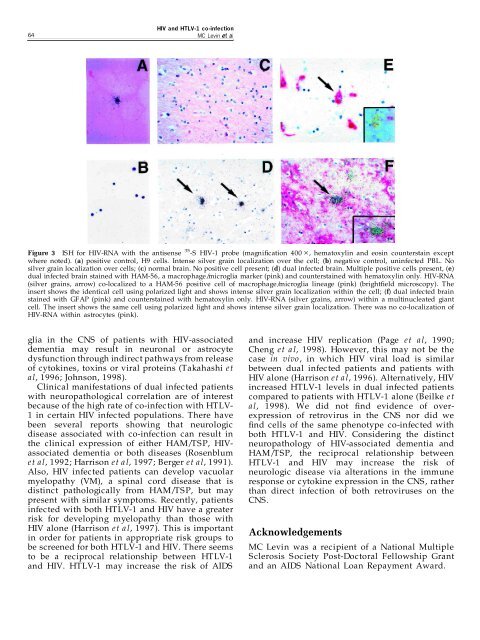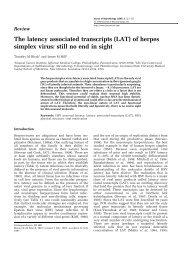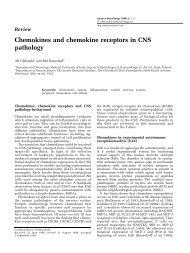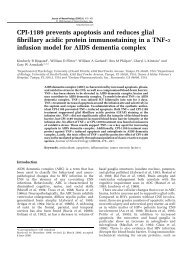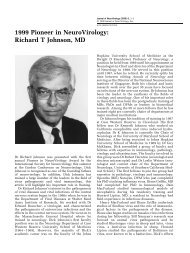Localization of retrovirus in the central nervous system of a patient ...
Localization of retrovirus in the central nervous system of a patient ...
Localization of retrovirus in the central nervous system of a patient ...
You also want an ePaper? Increase the reach of your titles
YUMPU automatically turns print PDFs into web optimized ePapers that Google loves.
64<br />
HIV and HTLV-1 co-<strong>in</strong>fection<br />
MC Lev<strong>in</strong><br />
Figure 3 ISH for HIV-RNA with <strong>the</strong> antisense 35 -S HIV-1 probe (magni® cation 400 ´ , hematoxyl<strong>in</strong> and eos<strong>in</strong> countersta<strong>in</strong> except<br />
where noted). (a) positive control, H9 cells. Intense silver gra<strong>in</strong> localization over <strong>the</strong> cell; (b) negative control, un<strong>in</strong>fected PBL. No<br />
silver gra<strong>in</strong> localization over cells; (c) normal bra<strong>in</strong>. No positive cell present; (d) dual <strong>in</strong>fected bra<strong>in</strong>. Multiple positive cells present, (e)<br />
dual <strong>in</strong>fected bra<strong>in</strong> sta<strong>in</strong>ed with HAM-56, a macrophage/microglia marker (p<strong>in</strong>k) and countersta<strong>in</strong>ed with hematoxyl<strong>in</strong> only. HIV-RNA<br />
(silver gra<strong>in</strong>s, arrow) co-localized to a HAM-56 positive cell <strong>of</strong> macrophage/microglia l<strong>in</strong>eage (p<strong>in</strong>k) (bright® eld microscopy). The<br />
<strong>in</strong>sert shows <strong>the</strong> identical cell us<strong>in</strong>g polarized light and shows <strong>in</strong>tense silver gra<strong>in</strong> localization with<strong>in</strong> <strong>the</strong> cell; (f) dual <strong>in</strong>fected bra<strong>in</strong><br />
sta<strong>in</strong>ed with GFAP (p<strong>in</strong>k) and countersta<strong>in</strong>ed with hematoxyl<strong>in</strong> only. HIV-RNA (silver gra<strong>in</strong>s, arrow) with<strong>in</strong> a mult<strong>in</strong>ucleated giant<br />
cell. The <strong>in</strong>sert shows <strong>the</strong> same cell us<strong>in</strong>g polarized light and shows <strong>in</strong>tense silver gra<strong>in</strong> localization. There was no co-localization <strong>of</strong><br />
HIV-RNA with<strong>in</strong> astrocytes (p<strong>in</strong>k).<br />
glia <strong>in</strong> <strong>the</strong> CNS <strong>of</strong> <strong>patient</strong>s with HIV-associated<br />
dementia may result <strong>in</strong> neuronal or astrocyte<br />
dysfunction through <strong>in</strong>direct pathways from release<br />
<strong>of</strong> cytok<strong>in</strong>es, tox<strong>in</strong>s or viral prote<strong>in</strong>s (Takahashi et<br />
al, 1996; Johnson, 1998).<br />
Cl<strong>in</strong>ical manifestations <strong>of</strong> dual <strong>in</strong>fected <strong>patient</strong>s<br />
with neuropathological correlation are <strong>of</strong> <strong>in</strong>terest<br />
because <strong>of</strong> <strong>the</strong> high rate <strong>of</strong> co-<strong>in</strong>fection with HTLV-<br />
1 <strong>in</strong> certa<strong>in</strong> HIV <strong>in</strong>fected populations. There have<br />
been several reports show<strong>in</strong>g that neurologic<br />
disease associated with co-<strong>in</strong>fection can result <strong>in</strong><br />
<strong>the</strong> cl<strong>in</strong>ical expression <strong>of</strong> ei<strong>the</strong>r HAM/TSP, HIVassociated<br />
dementia or both diseases (Rosenblum<br />
et al, 1992; Harrison et a l, 1997; Berger et al, 1991).<br />
Also, HIV <strong>in</strong>fected <strong>patient</strong>s can develop vacuolar<br />
myelopathy (VM), a sp<strong>in</strong>al cord disease that is<br />
dist<strong>in</strong>ct pathologically from HAM/TSP, but may<br />
present with similar symptoms. Recently, <strong>patient</strong>s<br />
<strong>in</strong>fected with both HTLV-1 and HIV have a greater<br />
risk for develop<strong>in</strong>g myelopathy than those with<br />
HIV alone (Harrison et a l, 1997). This is important<br />
<strong>in</strong> order for <strong>patient</strong>s <strong>in</strong> appropriate risk groups to<br />
be screened for both HTLV-1 and HIV. There seems<br />
to be a reciprocal relationship between HTLV-1<br />
and HIV. HTLV-1 may <strong>in</strong>crease <strong>the</strong> risk <strong>of</strong> AIDS<br />
and <strong>in</strong>crease HIV replication (Page et al, 1990;<br />
Cheng et a l, 1998). However, this may not be <strong>the</strong><br />
case <strong>in</strong> vivo, <strong>in</strong> which HIV viral load is similar<br />
between dual <strong>in</strong>fected <strong>patient</strong>s and <strong>patient</strong>s with<br />
HIV alone (Harrison et a l, 1996). Alternatively, HIV<br />
<strong>in</strong>creased HTLV-1 levels <strong>in</strong> dual <strong>in</strong>fected <strong>patient</strong>s<br />
compared to <strong>patient</strong>s with HTLV-1 alone (Beilke e t<br />
al, 1998). We did not ® nd evidence <strong>of</strong> overexpression<br />
<strong>of</strong> <strong>retrovirus</strong> <strong>in</strong> <strong>the</strong> CNS nor did we<br />
® nd cells <strong>of</strong> <strong>the</strong> same phenotype co-<strong>in</strong>fected with<br />
both HTLV-1 and HIV. Consider<strong>in</strong>g <strong>the</strong> dist<strong>in</strong>ct<br />
neuropathology <strong>of</strong> HIV-associated dementia and<br />
HAM/TSP, <strong>the</strong> reciprocal relationship between<br />
HTLV-1 and HIV may <strong>in</strong>crease <strong>the</strong> risk <strong>of</strong><br />
neurologic disease via alterations <strong>in</strong> <strong>the</strong> immune<br />
response or cytok<strong>in</strong>e expression <strong>in</strong> <strong>the</strong> CNS, ra<strong>the</strong>r<br />
than direct <strong>in</strong>fection <strong>of</strong> both <strong>retrovirus</strong>es on <strong>the</strong><br />
CNS.<br />
Acknowledgements<br />
MC Lev<strong>in</strong> was a recipient <strong>of</strong> a National Multiple<br />
Sclerosis Society Post-Doctoral Fellowship Grant<br />
and an AIDS National Loan Repayment Award.


